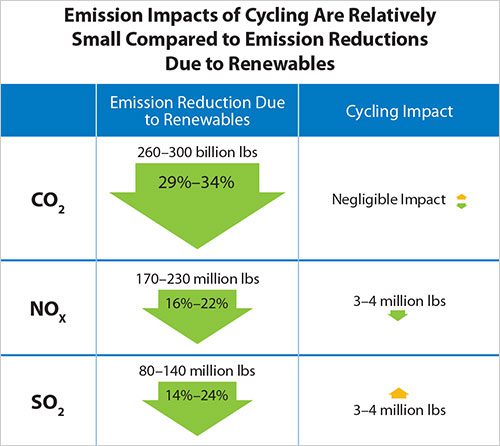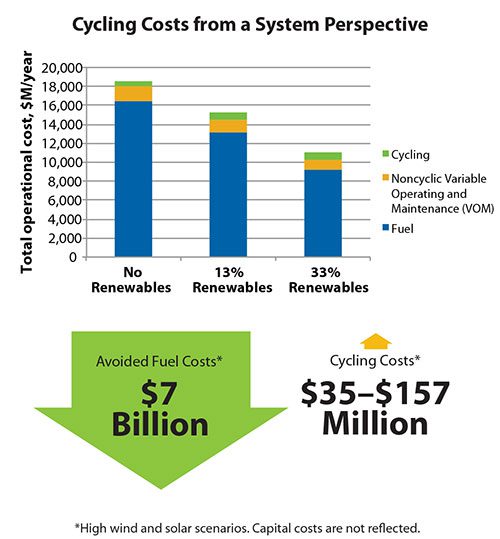 Those opposed to spurring development and adoption of renewable solar and wind energy resources continually assert that their intermittent nature not only reduces grid reliability and raises the cost of electricity, but negates the carbon and greenhouse gas emissions reductions that contribute so greatly to their rapid adoption in the first place.
Those opposed to spurring development and adoption of renewable solar and wind energy resources continually assert that their intermittent nature not only reduces grid reliability and raises the cost of electricity, but negates the carbon and greenhouse gas emissions reductions that contribute so greatly to their rapid adoption in the first place.
While it’s true that bringing greater amounts of solar and wind-generated electricity on grids means utilities have to cycle more frequently – ramp down and ramp up or stop and start – fossil fuel generators to ensure a smooth, reliable flow of electricity, a study by the US National Renewable Energy Laboratory (NREL) shows that the carbon emissions that result from cycling are negligible – less than 0.2% – of the carbon reductions realized by generating electricity from the sun and winds.
Not only that, but the research revealed that bringing “high levels of wind and solar power [on to the grid] would reduce fossil fuel costs by approximately $7 billion per year across the West, while incurring cycling costs of $35 million to $157 million per year.” That amounts to an increase in operations and maintenance costs of only $0.47-$1.28 per megawatt-hour (MWh) of electricity generation for the average fossil fuel power plant, according to a September 24 NREL press release.
How can this be? The explanation lies in the fossil fuel costs utilities avoid by making greater use of solar and wind energy generation.
Avoiding fossil fuel costs, and pollution
According to Debra Law, the project manager for NREL’s study,
“Grid operators have always cycled power plants to accommodate fluctuations in electricity demand as well as abrupt outages at conventional power plants, and grid operators use the same tool to accommodate high levels of wind and solar generation.
“Increased cycling to accommodate high levels of wind and solar generation increases operating costs by 2% to 5% for the average fossil-fueled plant. However, our simulations show that from a system perspective, avoided fuel costs are far greater than the increased cycling costs for fossil-fueled plants.”
Besides determining that the carbon emissions associated with greater cycling of fossil fuel generating capacity is negligible (<0.2%) compared to the reductions from bringing wind and solar energy generation on to the grid, the NREL project team found that sulfur dioxide emissions reductions from wind and solar are 5% less than expected due to greater cycling of fossil fuel generators. Nitrogen oxide emissions reductions were 2% greater than expected.
This latest study, entitled “Phase 2 of the Western Wind and Solar Integration Study” (WWSIS-2), is a follow-up to NREL’s initial, May 2010 research into “the viability, benefits, and challenges of integrating high levels of wind and solar power into the western electricity grid.”

Impacts of 33% renewable energy on the Western Interconnection grid
To calculate the emissions and cost of wear-and-tear, the NREL research team designed five hypothetical scenarios to examine generating as much as 33% of the U.S. portion of the Western Interconnection power system for the year 2020 from wind and solar energy. “This is equivalent to a quarter of the power in the Western Interconnection (including Canada and Mexico) coming from wind and solar energy on an annual basis,” the report authors explain.
The researchers’ model also assumes a future average natural gas price of $4.60/MMBtu – an optimistic assumption given the volatility and uncertainty inherent in natural gas prices – as well as “significant cooperation between balancing authorities, and optimal usage of transmission capacity (i.e., not reserving transmission for contractual obligations).”
Modeling the entire Western Interconnection power system at five-minute intervals for each year, the researchers found “that high wind and solar scenarios reduce CO2 emissions by 29%-34% across the Western Interconnection, with cycling having a negligible impact.”
The modeled reductions in sulfur dioxide (SO2) were 5% less than anticipated due to greater cycling, yet SO2 emissions would nonetheless be reduced by 14%-24% in the high solar and wind scenarios. Nitrogen oxide emissions would be reduced by 16%-22%, 1%-2% greater than expected. Added Lew,
“Adding wind and solar to the grid greatly reduces the amount of fossil fuel — and associated emissions — that would have been burned to provide power. Our high wind and solar scenarios, in which one-fourth of the energy in the entire western grid would come from these sources, reduced the carbon footprint of the western grid by about one-third. Cycling induces some inefficiencies, but the carbon emission reduction is impacted by much less than 1%.”
On average, it takes 4 MWh or renewables to displace 1 MWh of coal generation and 3 MWh of natural gas, according to the researchers, with the ramping up and down of coal-fired power plants having the biggest potential increase in terms of cycling.
Other key takeaways from the report include:
- Because of sunset and sunrise, solar power creates the biggest ramping needs on the grid in this study. However, because we know the path of the sun through the sky every day of the year, system operators can predict these large ramping needs and plan accordingly. Solar variability due to fast-moving clouds is much less predictable, but it creates relatively smaller ramping needs.
- Errors in day-ahead wind forecasts can make it challenging for operators to decide which power plants need to be online the next day. However, because forecast accuracy increases four hours ahead compared with 24 hours ahead, a four-hour-ahead decision on whether to start up those power plants that can be ramped up relatively quickly can help to mitigate these forecast errors.
- Despite the differences between wind and solar in terms of grid operations, the study finds their impacts on system-wide operational costs are remarkably similar.



